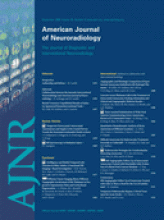Research ArticleBrain
Prediction of Functional Outcome in Acute Cerebral Hemorrhage Using Diffusion Tensor Imaging at 3T: A Prospective Study
Y. Kusano, T. Seguchi, T. Horiuchi, Y. Kakizawa, T. Kobayashi, Y. Tanaka, K. Seguchi and K. Hongo
American Journal of Neuroradiology September 2009, 30 (8) 1561-1565; DOI: https://doi.org/10.3174/ajnr.A1639
Y. Kusano
T. Seguchi
T. Horiuchi
Y. Kakizawa
T. Kobayashi
Y. Tanaka
K. Seguchi

References
- ↵
- Sawlani V,
- Gupta RK,
- Singh MK,
- et al
- ↵
- Cho SH,
- Kim SH,
- Choi BY,
- et al
- ↵
- Ward NS,
- Newton JM,
- Swayne OB,
- et al
- ↵
- Inoue Y,
- Matsumura Y,
- Fukuda T,
- et al
- ↵
- Binkofski F,
- Seitz RJ,
- Arnold S,
- et al
- ↵
- Mukherjee P
- ↵
- ↵
- Yang Q,
- Tress BM,
- Barber PA,
- et al
- ↵
- ↵
- Pierpaoli C,
- Barnett A,
- Pajevic S,
- et al
- ↵
- Thomalla G,
- Glauche V,
- Koch MA,
- et al
- ↵
- Werring DJ,
- Toosy AT,
- Clark CA,
- et al
- ↵
- Kuzu Y,
- Inoue T
- ↵
- Yoshida H,
- Horikoshi T,
- Aoki S,
- et al
- ↵
- Yokoyama K,
- Matsuki M,
- Shimano H,
- et al
- ↵
- van Swieten JC,
- Koudstaal PJ,
- Visser MC,
- et al
- ↵
- Mahoney F,
- Barthel D
- ↵
- Brott T,
- Adams HP Jr.,
- Olinger CP,
- et al
- ↵
- Hemphill JC 3rd.,
- Bonovich DC,
- Besmertis L,
- et al
- ↵
- Cheung RT,
- Zou LY
- ↵
- Ganesan V,
- Ng V,
- Chong WK,
- et al
- ↵
- Kuhn MJ,
- Mikulis DJ,
- Ayoub DM,
- et al
- ↵
- Delsing BJP,
- Catsman-Berrevoets CE,
- Appel IM
- ↵
- ↵
- de Haan R,
- Limburg M,
- Bossuyt P,
- et al
- ↵
- Uyttenboogaart M,
- Luijckx GJ,
- Vroomen PC,
- et al
-
- Liang Z,
- Zeng J,
- Liu S,
- et al
- ↵
- Nieuwenhuys R,
- Voogd J,
- van Huijzen C
- ↵
- Aoki S,
- Iwata NK,
- Masutani Y,
- et al
- ↵
- Frank LR
- ↵
- Tuch DS,
- Reese TG,
- Wiegell MR,
- et al
- ↵
- Kabasawa,
- Alexander AL,
- Hasan KM,
- et al
- ↵
- Masutani Y,
- Aoki S,
- Abe O,
- et al
- ↵
In this issue
Advertisement
Y. Kusano, T. Seguchi, T. Horiuchi, Y. Kakizawa, T. Kobayashi, Y. Tanaka, K. Seguchi, K. Hongo
Prediction of Functional Outcome in Acute Cerebral Hemorrhage Using Diffusion Tensor Imaging at 3T: A Prospective Study
American Journal of Neuroradiology Sep 2009, 30 (8) 1561-1565; DOI: 10.3174/ajnr.A1639
0 Responses
Prediction of Functional Outcome in Acute Cerebral Hemorrhage Using Diffusion Tensor Imaging at 3T: A Prospective Study
Y. Kusano, T. Seguchi, T. Horiuchi, Y. Kakizawa, T. Kobayashi, Y. Tanaka, K. Seguchi, K. Hongo
American Journal of Neuroradiology Sep 2009, 30 (8) 1561-1565; DOI: 10.3174/ajnr.A1639
Jump to section
Related Articles
- No related articles found.
Cited By...
- Predicting Motor Outcome in Acute Intracerebral Hemorrhage
- Tuberothalamic Artery Infarctions following Coil Embolization of Ruptured Posterior Communicating Artery Aneurysms with Posterior Communicating Artery Sacrifice
- Wallerian Degeneration in the Corticospinal Tract Evaluated by Diffusion Tensor Imaging Correlates with Motor Deficit 30 Days after Middle Cerebral Artery Ischemic Stroke
This article has not yet been cited by articles in journals that are participating in Crossref Cited-by Linking.
More in this TOC Section
Similar Articles
Advertisement











